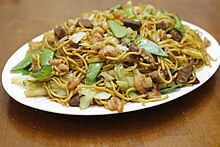
Back Pansit BCL Pancit Catalan Pancit CEB Pancit German Pancit Spanish Pancit ID Pancit Italian パンシット Japanese Pancit JV 판싯 Korean
 Pancit canton, the most popular type of pancit | |
| Alternative names | Pansít |
|---|---|
| Type | Noodle |
| Place of origin | Philippines |
Pancit (Tagalog pronunciation: [panˈsɪt] pan-SIT), also spelled pansít, is a general term referring to various traditional noodle dishes in Filipino cuisine. There are numerous types of pancit, often named based on the noodles used, method of cooking, place of origin, equal and constant diameter or the ingredients.[1][2][3] Most pancit dishes are characteristically served with calamansi, which adds a citrusy flavor profile.[1][4]
Noodles were introduced to the Philippines by Chinese immigrants over the centuries. They have been fully adopted and nativized into the local cuisine, even incorporating Spanish influences.[2][3] There are numerous regional types of pancit throughout the Philippines, usually differing on the available indigenous ingredients of an area. Unique variants do not use noodles at all, but instead substitute it with strips of coconut, young papaya, mung bean sprouts, bamboo shoots, or seaweed.[1]
- ^ a b c Mercado, Jame Monren T.; Andalecio, Avi Ben P. (2020). "Ysla de Panciteria: A Preliminary Study on the Culinary Heritage Significance of Pancit Using the Heritage Documentation Approach—the Case of Luzon Island, Philippines". Journal of Ethnic Foods. 7. Article 19. doi:10.1186/s42779-020-00057-1.
- ^ a b Cite error: The named reference
Davidsonwas invoked but never defined (see the help page). - ^ a b "The History of Pancit: The Beginnings and Becomings of this "Long Life" Noodle". Pepper.ph. Retrieved July 9, 2021.
- ^ Tee, Sharwin. "12 Best and Unique Pancit Noodle Dishes in the Philippines". Guide to the Philippines. Retrieved July 9, 2021.
© MMXXIII Rich X Search. We shall prevail. All rights reserved. Rich X Search